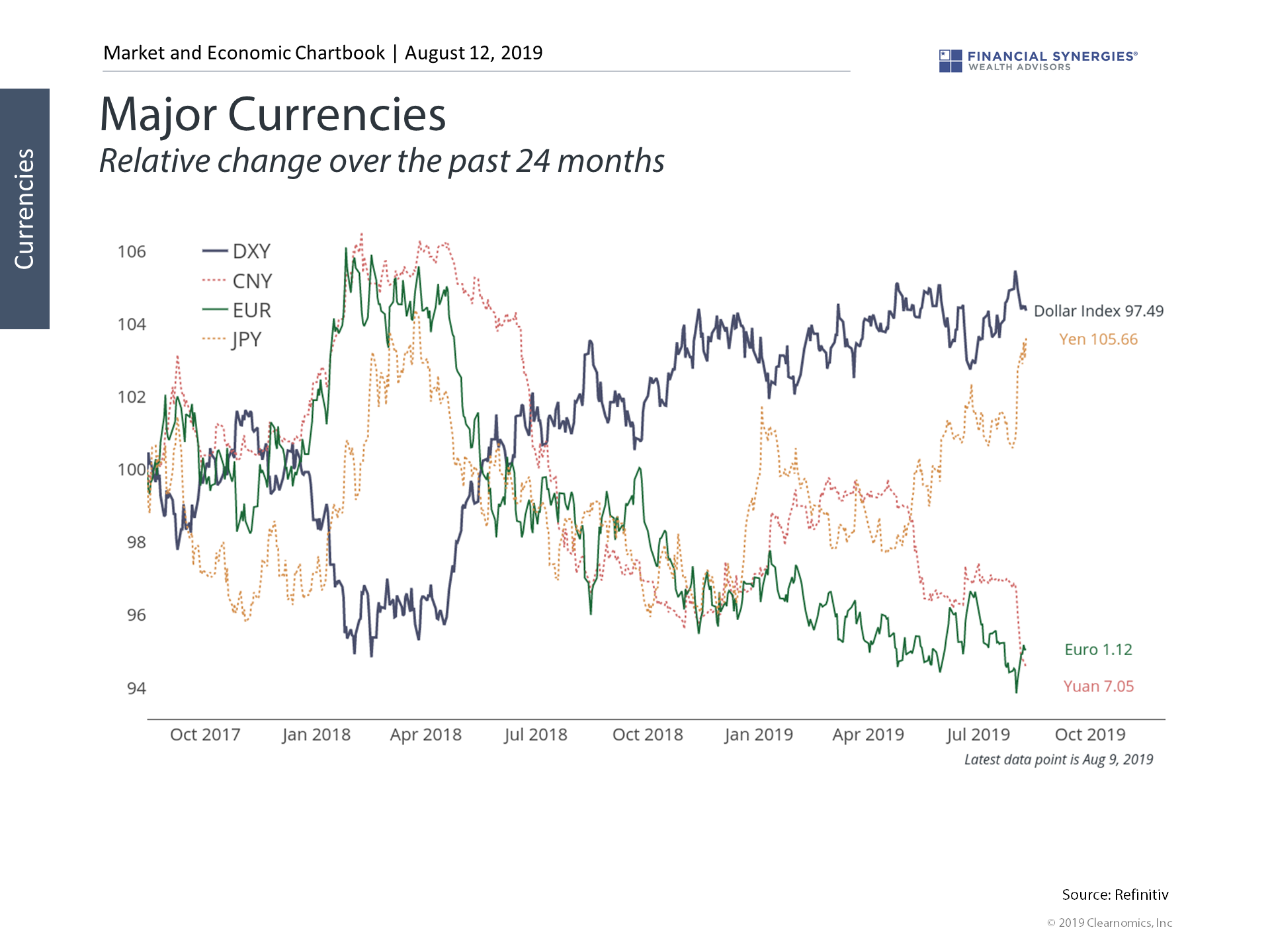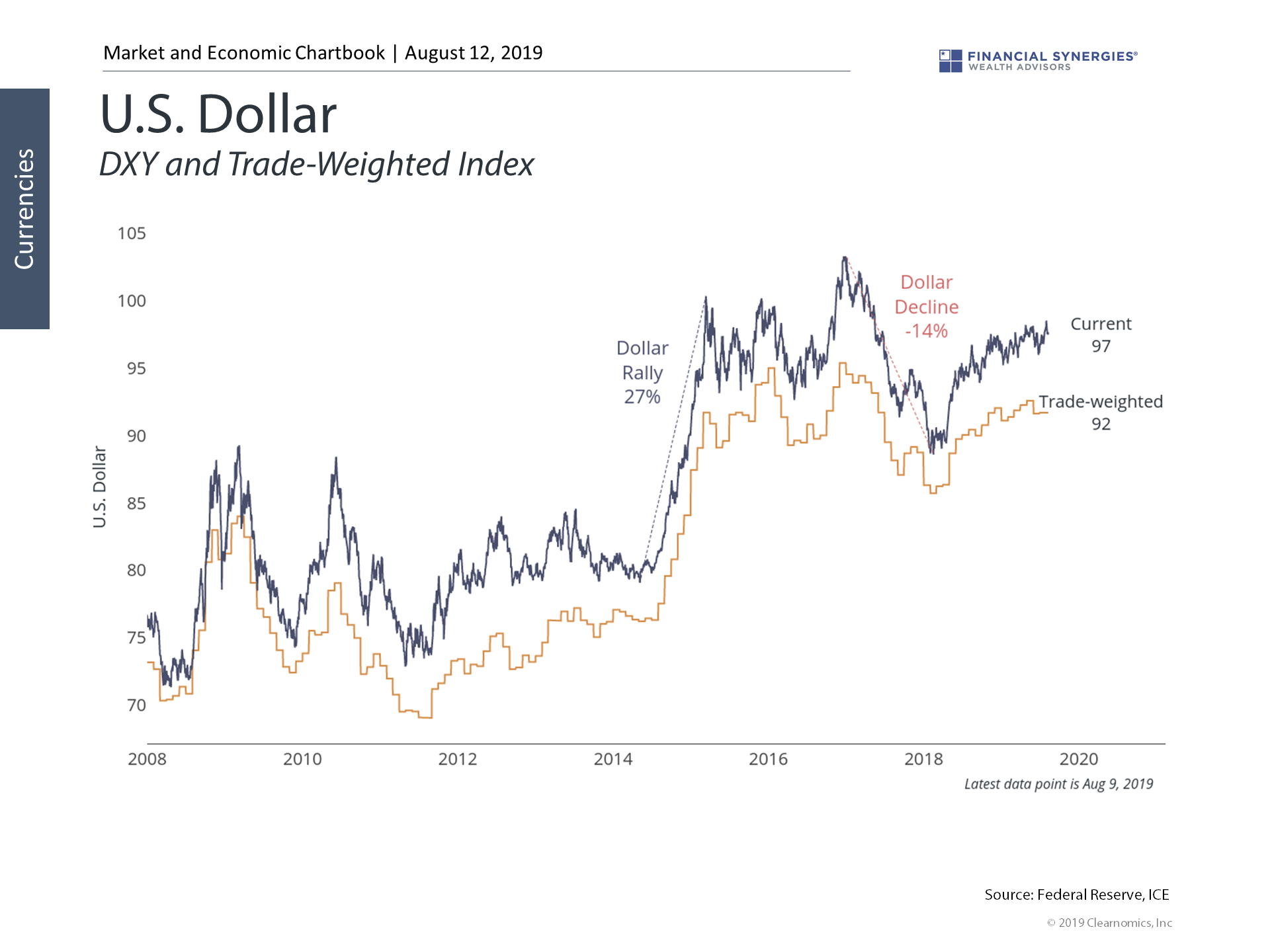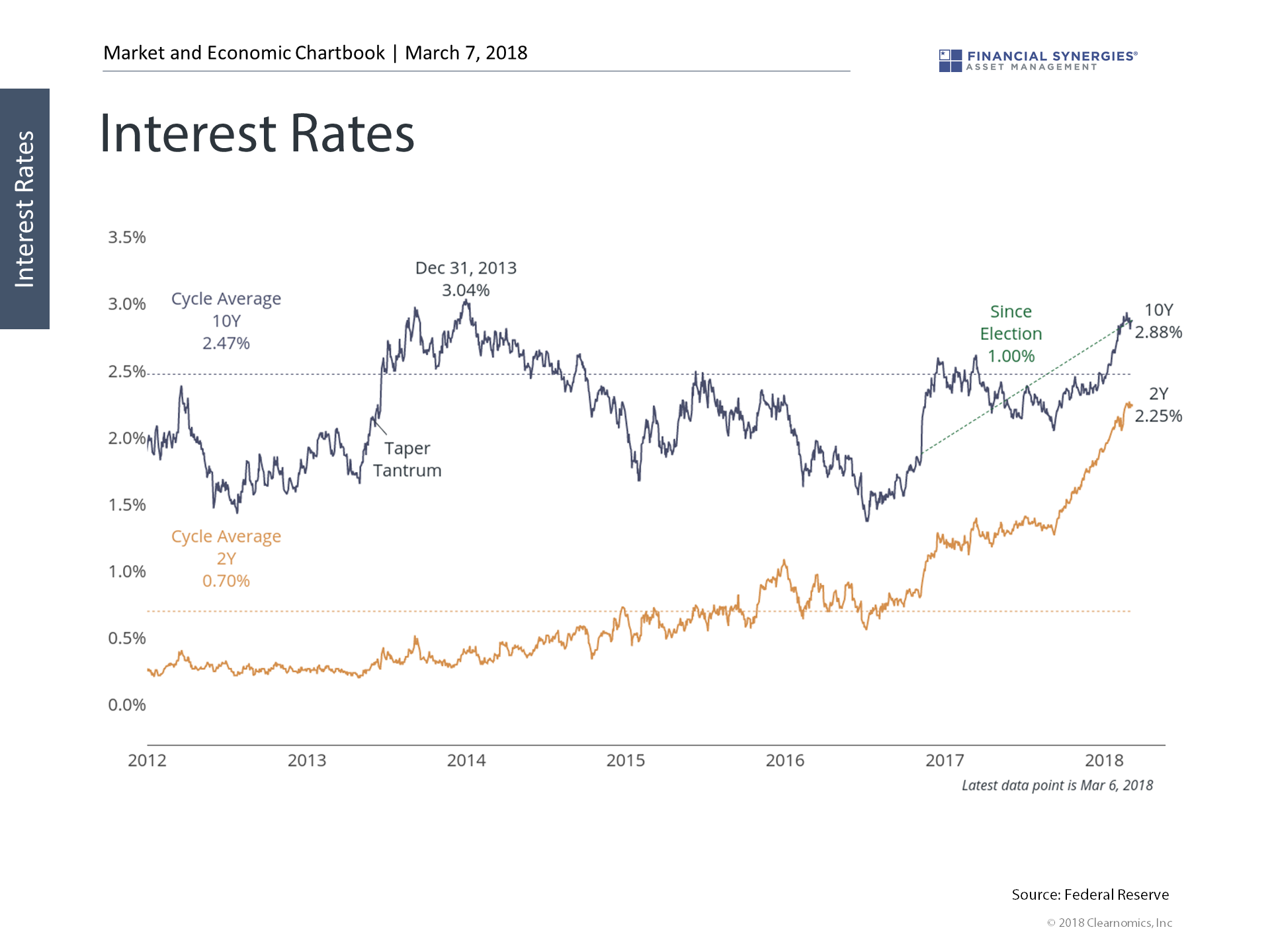For investors who focus too much on day-to-day headlines, the fact that several market and economic concerns have become intertwined is a major challenge. The recent Fed rate cut was partly in response to U.S.-China trade talks. In turn, both of these long-standing issues have conspired to strengthen the U.S. dollar and weaken the Chinese Yuan, leading the U.S. Treasury to designate China as a currency manipulator. Combined, all of these issues have increased market volatility and the perception of risk.
Currencies affect us in many ways. As consumers, the level of the U.S. dollar affects the prices at which we can import goods and services. A stronger dollar means we can import more which helps U.S. consumers. However, for those who operate and work at multi-national companies, a stronger dollar may hurt sales because our goods and services become more expensive to foreign buyers. Thus, for countries who depend heavily on exports, a weaker currency can be beneficial.
As investors, currencies are a valuable summary of the sea of macroeconomic data. All else equal, a country with stronger economic growth, higher interest rates, a healthier current account balance, among other factors, should have a stronger currency. The fact that currencies are always measured relative to one another means that the full global economic situation needs to be considered. In equilibrium, currency levels should reflect everything we know about the world.
To put this in perspective, four years ago China devalued its currency which sparked a global market correction. This was a result of slowing economic growth, extreme levels of debt, and fears of a so-called “hard-landing” in China. Although these fundamental issues were already known to investors and economists, it was the abrupt currency move that rippled across markets.
Today, the situation appears quite different. The recent devaluation of the Chinese Yuan and subsequent response from the Treasury Department most likely represent another round of escalating U.S.-China trade negotiation rather than something far worse. This isn’t to say that these events aren’t historic, or that trade issues couldn’t worsen further, but that this devaluation is quite different from what occurred in 2015.
What implications then, does this have for investors? From a currency perspective, the U.S. dollar has been strong over the past year and a half – one reason corporate earnings growth is expected to remain slow for some time. And while the devaluation of the Yuan has sparked some market volatility, the market is still less than 4% from all-time highs.
The bigger issue for most investors is that long-term interest rates have plummeted further. The 10-year Treasury yield, at only around 1.7%, is back to levels prior to the 2016 presidential election. Unfortunately, the search for yield will continue for some time, creating challenges for those who need income. The flip side is that mortgage and refinancing rates are low once again for those who can take advantage.
Below are three charts that provide perspective on recent events and highlight the impact on long-term investing.
1. The Chinese Yuan has devalued past important levels
 In response to new tariffs that may be implemented on September 1, the Chinese Yuan was allowed to devalue past 7 – an important trend, policy, and psychological level (a higher value of the Yuan means it is weaker relative to the U.S. dollar). This sparked some market volatility due to the echoes of past devaluations. The U.S. Treasury also escalated tensions further by labeling China as a currency manipulator.
In response to new tariffs that may be implemented on September 1, the Chinese Yuan was allowed to devalue past 7 – an important trend, policy, and psychological level (a higher value of the Yuan means it is weaker relative to the U.S. dollar). This sparked some market volatility due to the echoes of past devaluations. The U.S. Treasury also escalated tensions further by labeling China as a currency manipulator.
2. The dollar remains strong amid global economic uncertainty
 The U.S. dollar has been quite strong over the past year – and more broadly – since it appreciated in value in late 2014. A stronger dollar is a mixed blessing. A stronger currency can help consumers, since it increases our ability to import foreign goods and services. However, it hurts the profitability of multi-national companies since our dollar-denominated goods become more expensive on a relative basis.
The U.S. dollar has been quite strong over the past year – and more broadly – since it appreciated in value in late 2014. A stronger dollar is a mixed blessing. A stronger currency can help consumers, since it increases our ability to import foreign goods and services. However, it hurts the profitability of multi-national companies since our dollar-denominated goods become more expensive on a relative basis.
3. Interest rates have plummeted further
 Intertwined with global currencies is the fact that interest rates have plummeted over the past week. The 10-year Treasury is now at levels not seen since before the 2016 presidential election. The yield curve has flattened further, with the spread between 10Y and 2Y yields at only 0.11%.
Intertwined with global currencies is the fact that interest rates have plummeted over the past week. The 10-year Treasury is now at levels not seen since before the 2016 presidential election. The yield curve has flattened further, with the spread between 10Y and 2Y yields at only 0.11%.
Source: Clearnomics
How the U.S. and Chinese Currencies Affect Investors
For investors who focus too much on day-to-day headlines, the fact that several market and economic concerns have become intertwined is a major challenge. The recent Fed rate cut was partly in response to U.S.-China trade talks. In turn, both of these long-standing issues have conspired to strengthen the U.S. dollar and weaken the Chinese Yuan, leading the U.S. Treasury to designate China as a currency manipulator. Combined, all of these issues have increased market volatility and the perception of risk.
Currencies affect us in many ways. As consumers, the level of the U.S. dollar affects the prices at which we can import goods and services. A stronger dollar means we can import more which helps U.S. consumers. However, for those who operate and work at multi-national companies, a stronger dollar may hurt sales because our goods and services become more expensive to foreign buyers. Thus, for countries who depend heavily on exports, a weaker currency can be beneficial.
As investors, currencies are a valuable summary of the sea of macroeconomic data. All else equal, a country with stronger economic growth, higher interest rates, a healthier current account balance, among other factors, should have a stronger currency. The fact that currencies are always measured relative to one another means that the full global economic situation needs to be considered. In equilibrium, currency levels should reflect everything we know about the world.
To put this in perspective, four years ago China devalued its currency which sparked a global market correction. This was a result of slowing economic growth, extreme levels of debt, and fears of a so-called “hard-landing” in China. Although these fundamental issues were already known to investors and economists, it was the abrupt currency move that rippled across markets.
Today, the situation appears quite different. The recent devaluation of the Chinese Yuan and subsequent response from the Treasury Department most likely represent another round of escalating U.S.-China trade negotiation rather than something far worse. This isn’t to say that these events aren’t historic, or that trade issues couldn’t worsen further, but that this devaluation is quite different from what occurred in 2015.
What implications then, does this have for investors? From a currency perspective, the U.S. dollar has been strong over the past year and a half – one reason corporate earnings growth is expected to remain slow for some time. And while the devaluation of the Yuan has sparked some market volatility, the market is still less than 4% from all-time highs.
The bigger issue for most investors is that long-term interest rates have plummeted further. The 10-year Treasury yield, at only around 1.7%, is back to levels prior to the 2016 presidential election. Unfortunately, the search for yield will continue for some time, creating challenges for those who need income. The flip side is that mortgage and refinancing rates are low once again for those who can take advantage.
Below are three charts that provide perspective on recent events and highlight the impact on long-term investing.
1. The Chinese Yuan has devalued past important levels
2. The dollar remains strong amid global economic uncertainty
3. Interest rates have plummeted further
Source: Clearnomics
Recent Posts
2nd Quarter 2025 Market and Economic Review
The Market Reaches All-Time Highs
Last Week on Wall Street: Broad-Based Market Rally [June 30-2025]
Subscribe to Our Blog
Shareholder | Chief Investment Officer